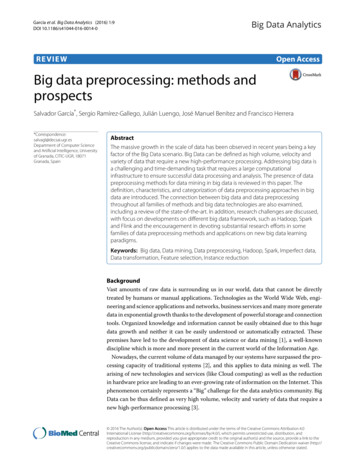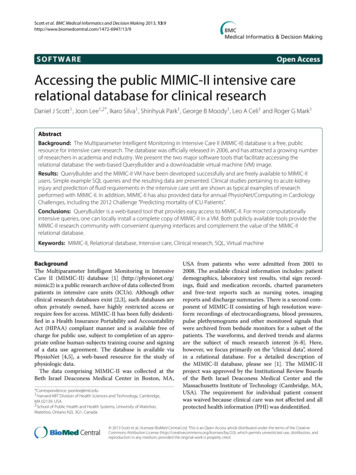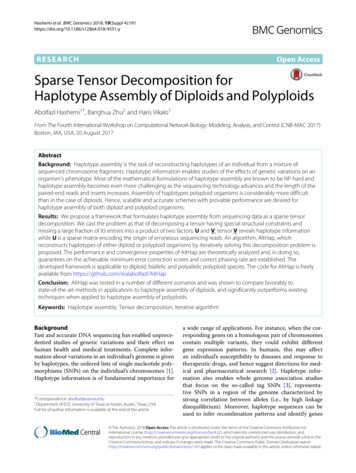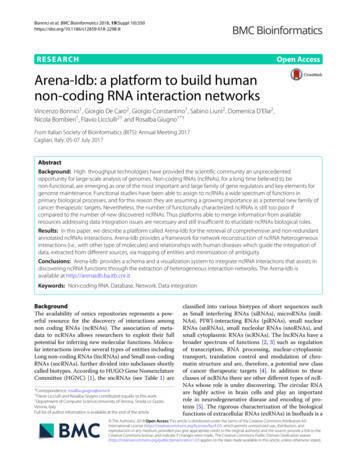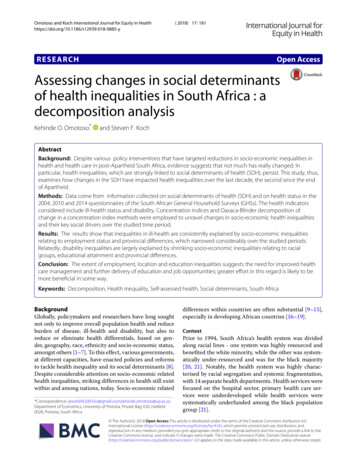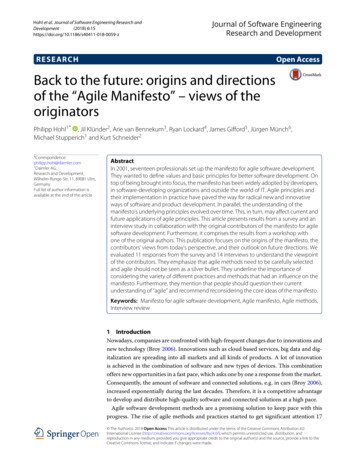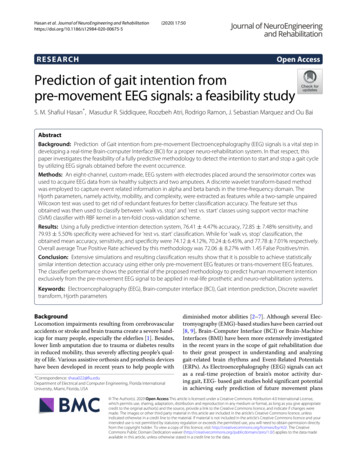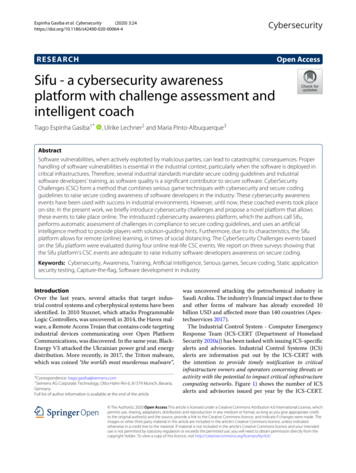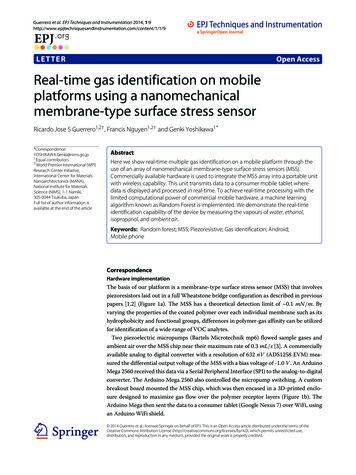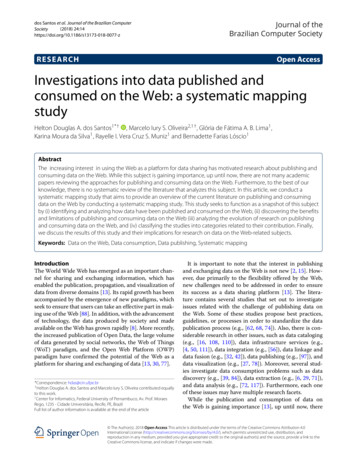
Transcription
dos Santos et al. Journal of the Brazilian Computer(2018) 7-zJournal of theBrazilian Computer SocietyR ES EA R CHOpen AccessInvestigations into data published andconsumed on the Web: a systematic mappingstudyHelton Douglas A. dos Santos1*† , Marcelo Iury S. Oliveira2,1† , Glória de Fátima A. B. Lima1 ,Karina Moura da Silva1 , Rayelle I. Vera Cruz S. Muniz1 and Bernadette Farias Lóscio1AbstractThe increasing interest in using the Web as a platform for data sharing has motivated research about publishing andconsuming data on the Web. While this subject is gaining importance, up until now, there are not many academicpapers reviewing the approaches for publishing and consuming data on the Web. Furthermore, to the best of ourknowledge, there is no systematic review of the literature that analyzes this subject. In this article, we conduct asystematic mapping study that aims to provide an overview of the current literature on publishing and consumingdata on the Web by conducting a systematic mapping study. This study seeks to function as a snapshot of this subjectby (i) identifying and analyzing how data have been published and consumed on the Web, (ii) discovering the benefitsand limitations of publishing and consuming data on the Web (iii) analyzing the evolution of research on publishingand consuming data on the Web, and (iv) classifying the studies into categories related to their contribution. Finally,we discuss the results of this study and their implications for research on data on the Web-related subjects.Keywords: Data on the Web, Data consumption, Data publishing, Systematic mappingIntroductionThe World Wide Web has emerged as an important channel for sharing and exchanging information, which hasenabled the publication, propagation, and visualization ofdata from diverse domains [13]. Its rapid growth has beenaccompanied by the emergence of new paradigms, whichseek to ensure that users can take an effective part in making use of the Web [88]. In addition, with the advancementof technology, the data produced by society and madeavailable on the Web has grown rapidly [8]. More recently,the increased publication of Open Data, the large volumeof data generated by social networks, the Web of Things(WoT) paradigm, and the Open Web Platform (OWP)paradigm have confirmed the potential of the Web as aplatform for sharing and exchanging of data [13, 30, 77].*Correspondence: hdas@cin.ufpe.br† Helton Douglas A. dos Santos and Marcelo Iury S. Oliveira contributed equallyto this work.1Center for Informatics, Federal University of Pernambuco, Av. Prof. MoraesRego, 1235 - Cidade Universitária, Recife, PE, BrazilFull list of author information is available at the end of the articleIt is important to note that the interest in publishingand exchanging data on the Web is not new [2, 15]. However, due primarily to the flexibility offered by the Web,new challenges need to be addressed in order to ensureits success as a data sharing platform [13]. The literature contains several studies that set out to investigateissues related with the challenge of publishing data onthe Web. Some of these studies propose best practices,guidelines, or processes in order to standardize the datapublication process (e.g., [62, 68, 74]). Also, there is considerable research in other issues, such as data cataloging(e.g., [16, 108, 110]), data infrastructure services (e.g.,[4, 50, 111]), data integration (e.g., [56]), data linkage anddata fusion (e.g., [32, 42]), data publishing (e.g., [97]), anddata visualization (e.g., [27, 78]). Moreover, several studies investigate data consumption problems such as datadiscovery (e.g., [39, 84]), data extraction (e.g., [6, 29, 71]),and data analysis (e.g., [72, 117]). Furthermore, each oneof these issues may have multiple research facets.While the publication and consumption of data onthe Web is gaining importance [13], up until now, there The Author(s). 2018 Open Access This article is distributed under the terms of the Creative Commons Attribution 4.0International License (http://creativecommons.org/licenses/by/4.0/), which permits unrestricted use, distribution, andreproduction in any medium, provided you give appropriate credit to the original author(s) and the source, provide a link to theCreative Commons license, and indicate if changes were made.
dos Santos et al. Journal of the Brazilian Computer Society(2018) 24:14are not many academic papers that reviewed this subject. In particular, currently available studies focus onsome specific approaches such as Linked Data reflecting only a small fragment of the whole set of optionsrelated to the publication and consumption of data on theWeb [59].To the extent of our knowledge, Abiteboul et al. [2] wereone of the first to use term data on the Web. According to them, data on the Web refers to the use of theWeb infrastructure and its set of standards to support dataexchange. In particular, they advocate for the use of XMLand related standards (e.g., XSLT and XSD) to publish dataon the Web. Abiteboul et al. [2] and many other projectsconducted at that time led to a significant progress onusing Web as a platform to data exchange. In more recentyears, the highly development of Web-related technologies opened up various forms of producing, publishing,sharing, and consuming data. In this context, this paperoffers a perspective on the contributions on publishingand consuming data on the Web made in the last 11 years.It also describes some of the important bodies of work andoutlines’ relevant challenges to current data on the Webresearch. We note in advance that this is not intended tobe a comprehensive survey of all the approaches and bestpractices used to publish and consume data on the Web,and even though the reference list is long, it is by no meanscomplete.Therefore, in this article, we provide an overview ofthe current literature on publishing and consuming dataon the Web by conducting a systematic mapping study.Systematic mapping is a protocol-driven methodology forreviewing and synthesizing a research data area [67]. Asystematic mapping study typically provides an overviewof the research reported in the field and identifies possible issues arising from examining the existing literature. This study seeks to function as a snapshot of thedata on the Web publication and consumption by (i)identifying and analyzing how data have been publishedand consumed on the Web, (ii) discovering the benefits and limitations of publishing and consuming dataon the Web (iii) analyzing the evolution of research onpublishing and consuming data on the Web, and (iv)classifying the studies into categories related to theircontribution.The rest of the work is organized as follows. In the“Theoretical background” section, we discuss the theoretical background. In the “Related works” section,we present the related works. In the “Researchapproach” section, we describe the research methodologyused in our study. In the “Results” section, we presentthe result analysis. A discussion about open issues is presented in the “Discussion and research directions” section.Finally, in the “Conclusions” section, we present ourconclusions.Page 2 of 22Theoretical backgroundIn general, articles on publishing and consuming dataon the Web often refer to a set of best practices andapproaches closely aligned to the general architecture ofthe Web [63, 75]. In summary, Jacobs and Walsh [63] statethat the Web is composed of a set of resources uniquelyidentified by Uniform Resource Identifiers (URIs), whoserepresentation can be usually retrieved via standardizedformats. A resource representation encodes informationabout the resource, and state is usually typed. HTML,RDF, XML, or CSV are examples of data formats. Agentsor users can interact with Web resources using standardized protocols, which control the exchange of messagesHTTP, FTP, and SOAP, for example. Messages includeboth data and metadata. The development and use of suchstandards enable the Web to transcend different technicalarchitectures. It is possible to use generic data browsersto explore the data available on the Web [18], for example.In fact, both humans and machines can gather data fromWeb.In particular, data published on the Web deals withspecific types of Information Resources1 called datasets,which are collections of data, published or curated bya single agent, and available for access or downloadin one or more formats [76]. A dataset does not haveto be available as a downloadable file, but it can beaccessed through a Web API or data stream. Moreover,data should also be available in machine-readable formats, provided in a convenient form, and offered withouttechnological barriers for data consumers. Therefore,data must be released in formats that reasonably structure the data, but that also allows automated processing and facilitates machine sorting and searchingactivities.In the following, we present relevant aspects related topublishing and consuming of data on the Web.Data on the Web lifecycleWithin the Web environment, there are several activitiesthat make up the process of publishing and consumingdata, ranging from dataset planning and creation to accessand process of datasets. According to Lóscio et al. [73],the set of these activities is called the lifecycle of data onthe Web, during which data are being created, published,exported, imported, consumed, processed, and reused bydifferent parties and for different purposes. In this way,understanding the lifecycle allows a better understandingabout the nature of the data as well as provide a sharedvocabulary that allows different practitioners to discussabout essential issues related to the publishing and consumption of data on the Web. In addition, a data lifecyclehelps to explain paradigm shifts, to compare the functionality of different platforms, and to aid the integration ofpreviously disparate implementation efforts [82].
dos Santos et al. Journal of the Brazilian Computer Society(2018) 24:14Möller [82] proposes the Abstract Data Lifecycle Model(ADLM), which is a generic model for lifecycle representation for data and metadata, establishing a commonset of phases, characteristics, and roles. According toADLM, a lifecycle for data-centric domains must consistof the ontology development, planning, creation, archiving, refinement, publication, access, external use, feedback, and termination phases. Due to its generic nature,it can be used to construct new data-centric lifecyclemodels.However, some ADLM phases are not suitable forall data environments. According to Lóscio et al. [73],the Web Data context does not include ontology development, archiving, and termination phases. Moreover,Lóscio et al. [73] state that the ontology development isan independent activity and therefore was not included. Ina similar way, the archiving and termination phases werenot considered because once the data has been publishedon the Web, it should be always available. In this sense,Fig. 1 presents a lifecycle for data published and consumedon the Web proposed by Lóscio et al. [73] and based onADLM model. Although it is a cycle, it is possible that notall steps are followed until a new iteration begins. Thus,even though it is a cycle, this does not mean that the datahave to go through the last stage before starting a new iteration or that feedback needs to be received just before theproducer refines the data. During this process, actors playthe role of data producer and consumer, where, in general,the producer is responsible for creating or publishing thedata. On the other hand, consumers are responsible forconsuming the data, and may also be producers, since theycan make improvements to and refine the data in order topublish them again [73].All phases are briefly described below.Fig. 1 Data on the Web lifecycle. Adapted from [73]Page 3 of 22 Planning: Ranges from the intention to publish thedata to the selection of the data that will be published[73]. Lóscio et al. [73] points out that it is importantto take into account the potential of data usage and,where possible, to ask potential data consumers toidentify relevant data. Creation : Ranges from data extraction phase to datatransformation (i.e., transforming data intoappropriate format for Web publishing). Thecreation phase also comprises the metadata creation,which will describe the data [73]. It is important toconsider publishing in different formats(distributions), minimizing the need for thetransformation of data by consumers [74]. Publication: Makes data available on the Web in aform for (re)use by others. It involves the tasksfocused on keeping the data accessible. Often, datacataloging tools are used to publish data [73]. Toguarantee the appropriate access to metadata, it isadvised to provide a suitable search engine to retrievethese data. It also may involve controlling the accessto data. Access: Consists of the act when users gain access tothe data [73]. Consumption: Comprises series of actions andmethods related to the manipulation and analyses ofthe collected data. In fact, it is the actual use of thedata. This stage of the lifecycle is directly related tothe data consumer. Among consumers, we canmention from a developer interested in creating anapplication that makes use of the data, as peopleinterested in transforming the data to generaterelevant information, as well as large companiesinterested in using data to improve their products
dos Santos et al. Journal of the Brazilian Computer Society(2018) 24:14and services and , even another system that consumesthe data. Feedback: Comprises the moment when consumersshould provide comments on the data and metadataused, allowing to identify improvements andcorrections in the published data, as well as tomaintain a channel of communication betweenproducers and consumers [73]. Refinement: Comprises all activities related toimprovements and updates into published data. It isrelated to the guarantee of maintenance of thepreviously published data and that can be realizedfrom the comments of feedback collected in theprevious phase. In addition, Lóscio et al. [73] statethat refinement can be done either by generating newversions to ensure that the data is not obsolete, bycorrectly managing the different versions or byproviding access to the correct version of the data forconsumers.Data on the Web EcosystemThe data on the Web Ecosystem may be defined as a setof actors and artifacts involved in producing, distributing,and consuming data by using the Web [75]. An actor canbe a user, a system, or a device and can act either as adata producer or as a data consumer. The former delivers and produces data of some type according to specificconditions. The latter consumes (e.g., processes, analyzes,filters, aggregates) data. Both actors interact with eachother by exchanging datasets.Examples of data on the Web ecosystems are Open Government Data Initiatives [8]. In these initiatives, governments act as data producer making their data available inmachine-readable formats and under open licensing conditions that allow the use and redistribution of the data.Entrepreneurs, application developers, or citizens act asdata consumers by creating new information products andservices, visualizations, and mash-ups that allow to monitor the activities of their government, as well as creatingtools to make daily life easier. Such available governmentdata have the ability to facilitate networks of collaboration and co-creation to produce citizen empowermentas well as promote accountability and other democraticprinciples.Producers are responsible for data publication activities,such as defining licenses, choosing formats, and platformsfor distribution. Furthermore, they can provide one ormore access interfaces to retrieve data. Each interfacedetermines the requirements to be satisfied by data consumers in order to successfully use the service, such asparameters, outputs, and operations. Moreover, data consumers consume data according to specific requirements,which are the conditions and the capabilities needed tosolve a problem or achieve an objective.Page 4 of 22In order to consume or produce datasets, consumersand producers, respectively, must coordinate a set of activities, which represent a piece of work that forms onelogical step (i.e., operation) within a consumption or production process. According to Dittrich and Jonscher [41],choosing a particular set of activities may depend on theintended use of the data, the capability of the actor, thecharacteristics of the data (e.g., alphanumeric data, multimedia data; structured, semi-structured, unstructureddata), requirements concerning data quality, service performance requirements, and the available resources (e.g.,human resources, time, money)In summary, data on the Web Ecosystems rely on avast and heterogeneous set of actors, each one with different properties, capabilities, and expectations. Similarly,datasets are heterogeneous regarding structural (schema),syntactic (format), and semantic (meaning) issues. Actorsmay produce and consume a dataset using different activities and under different conditions. Also, many of theseelements are dynamic and evolve with time. We may conclude that the data on the Web Ecosystem landscape is oneof the distributed, heterogeneous, dynamic, and evolvingactors and resources.The emergence of data on the Web Ecosystems hasbeen driven by several factors, including the emergence ofdigital technologies and political/institutional initiatives.For instance, the majority of Data Ecosystems have beendriven mostly by the open data movement, which calls forfree use, reuse, and redistribution of data by anyone [55].Several governments already launched Open Data Portalsto stimulate and promote Open Data production and consumption [33]. The technology improvement (e.g., mobileInternet or technology) and technology trends (e.g., socialmedia or mobile apps) also have been driving private andpublic organizations to publish data as well as to integratetheir services with external data.Related worksThere are some studies that analyze the state of the art ofsome of the approaches used to publish and consume dataon the Web. For instance, Bizer [18] presents an overviewon the major Linked Data providers and also the fewefforts on how to build applications that exploit the Webof Linked Data. In [19], the authors extended [18] analysis by presenting conceptual and technical principles ofLinked Data. They also situate these principles within thebroader context of related technological developments.Moreover, they also reviewed applications developed toexploit and publish Linked Data. More recently, Bikakisand Sellis [17] describe the major pre-requisites and challenges that should be addressed by up-to-date approachesto exploring and visualizing very large linked datasets.There are some studies that review specific applicationdomains on Linked Data. For instance, Barnaghi et al. [12]
dos Santos et al. Journal of the Brazilian Computer Society(2018) 24:14review some of the recent developments on applyingthe Linked Data technologies to the Internet of Things.In particular, they focus on the information modeling,ontology design, and processing of semantic data problems. They describe the initial progress and some of thedevelopments. They also discuss the future prospects andchallenges of developing efficient semantic-enabled IoTsystems. Similarly, Bröring et al. [25] illustrates and analyzes the recent developments on applying Linked Dataprinciples for sensor technologies. Bröring et al. [25] alsopoint out challenges and future topics for research onsemantic sensors.From the Open Data perspective, Zuiderwijk et al. [119]present a survey study on the impediments to usingOpen Data. According to them, the main Open Dataissues are (1) availability and access, (2) discoverability, (3)usability, (4) understandability, (
dosSantosetal.JournaloftheBrazilianComputerSociety (2018) 24:14 Page3of22 Möller[82]proposestheAbstractDa
